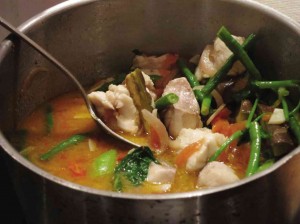
The recent Philippine Independence Day celebrations had Makati Shangri-La hotel offering its own fiesta of Filipino food. Served for lunch and dinner at the Circles Event Café last June 9-15, the Kalayaan Food Festival featured much-loved Filipino dishes including kare-kare, pancit palabok, sisig, kinilaw, lechon, sinigang, adobo, palitaw and sapin-sapin all decked in five-star fineries.
It wasn’t just the presentation that gave these dishes their luxurious appeal. With Shangri-La executive sous chef Gene del Prado in charge of food preparation, the dishes exuded the classic flavors and aroma of old-fashioned Filipino cuisine, as though they had been cooked by a loving grandmother and her coterie of helpers in a place where patience was plentiful and time passed unnoticed.
The kare-kare, for example, was thickened with rice grains that had been toasted to brownness, then processed to a fine powder.
The sauce for the pancit palabok was brightened by homemade achuete oil, its vermilion color extracted from seeds slowly simmered in corn oil.
The pork for the sisig had been tenderly massaged with native coarse salt before being roasted in the oven until it became brown and crisp.
Impressive as all those efforts may be, for chef Gene it was no big deal. It’s just the way he has been cooking Filipino food since he started his career as a chef. He learned many of these techniques from his own father, who was himself a chef at the restaurant of the old Manila Jai Alai building, and from a grumpy old cook who used to head the kitchen of a once popular Filipino restaurant in Makati.
I was lucky enough to attend the cooking class that chef Gene conducted at the Makati Shangri-La last week. From him I learned how to make flavorful chicken adobo, sinigang sa miso, crispy sisig, as well as the aforementioned kare-kare and pancit palabok. The class also gave me some assurance that Makati Shangri-La’s preparation of kinilaw fish steeped in vinegar and spices was methodical and hygienic.
Chef Gene made sure to wear clean gloves while handling the raw fish and bathing them in vinegar and when dousing the fish with the zesty seasoning of ginger, calamansi, vinegar, pepper, shallots and chilies. When I saw the kinilaw on the buffet table at lunch right after class, I had no reservation about tasting a generous helping.
Here’s chef Gene’s recipe for sinigang sa miso, which I lost no time in preparing at home that evening. The miso-fermented bean paste tames the acidity of the sinigang mix and gives the dish a rich, mellow flavor.
Sinigang na Lapu-Lapu sa Miso at Kamias
- 1 whole lapu-lapu, about 1.2-1.5 kg
- 2 tbsp corn oil
- 1 medium-size red onion, chopped
- 2-3 cloves garlic, chopped
- 1-2 medium-size ripe tomatoes, sliced thinly lengthwise
- ½ c yellow miso paste (about 80 g)
- 4 c water
- 1 medium eggplant, sliced diagonally into ½-inch pieces
- 3-4 stems string beans, cut into
- 2-inch lengths
- 1 small radish, cut into rounds
- 4-6 pieces kamias, sliced into rounds
- 4-6 stalks kangkong (swamp cabbage)
- 2-3 long green chilies (siling haba)
- ½ of a 40-g or 60-g pack sinigang powder mix (See tips.)
- 1-2 tbsp patis (fish sauce)
Clean lapu-lapu well, then slice into fillets. Remove any sharp bones (you can use tweezers to do this).
In a large casserole, heat the corn oil to medium heat. Sauté the onions until tender. Stir in the garlic, then add the tomatoes. Sauté until the tomatoes are wilted. Add the miso paste and continue sautéing to blend the miso with the other ingredients.
Pour in the water and bring to a boil. When the water is boiling, add the eggplants, string beans, radish and kamias. Lower heat to a simmer. Let simmer until the vegetables are almost tender, then add the lapu-lapu fillets, kangkong and the long chilies.
When vegetables are tender, add the sinigang powder mix. Season with patis and continue simmering until the fish fillets are fully cooked (don’t overcook or the fish will disintegrate). Serve hot with rice and additional patis on the side. Makes three to four servings.
For more tips, recipes and stories, visit author’s blog, www.normachikiamco.com, and Facebook fan page, www.facebook.com/normachikiamco. Follow on Twitter @NormaChikiamco.
Cook’s tips:
From chef Gene: Do not put too much water when cooking dishes such as sinigang and nilaga so as not to dilute the flavor.
He recommends tenderizing the vegetables first before adding the sinigang powder mix because the acidity of the sinigang mix could prevent the vegetables from becoming tender.
To prepare this ahead: Have the lapu-lapu already cleaned and cut into fillets. Sauté the onion, garlic and tomatoes (it takes time to wilt the tomatoes). Add and sauté the miso paste. Keep covered. About 15-20 minutes before serving time, pour in the water and bring to a boil. Add the vegetables and simmer until vegetables are almost tender (about five minutes). Add the lapu-lapu, kangkong and the long chilies. When the vegetables are tender, stir in the sinigang powder mix and season with patis. Continue simmering until the fish fillets are fully cooked.









































